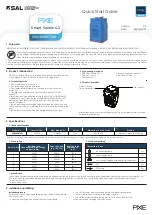
FEFD State Changes
FEFD has two operational modes, Normal and Aggressive.
When you enable Normal mode on an interface and a far-end failure is detected, no intervention is required to reset the interface to bring it
back to an FEFD operational state. When you enable Aggressive mode on an interface in the same state, manual intervention is required to
reset the interface.
FEFD enabled systems (comprised of one or more interfaces) automatically switches between four different states: Idle, Unknown, Bi-
directional, and Err-disabled.
1
An interface on which FEFD is not configured is in Normal mode by default.
2
After you enable FEFD on an interface, it transitions to the Unknown state and sends an FEFD packet to the remote end of the link.
3
When the local interface receives the echoed packet from the remote end, the local interface transitions to the Bi-directional state.
4
If the FEFD enabled system is configured to use FEFD in Normal mode and neighboring echoes are not received after three intervals,
(you can set each interval can be set between 3 and 300 seconds) the state changes to unknown.
5
If the FEFD system has been set to Aggressive mode and neighboring echoes are not received after three intervals, the state changes
to Err-disabled. You must manually reset all interfaces in the Err-disabled state using the
fefd reset [interface]
command in
EXEC privilege mode (it can be done globally or one interface at a time) before the FEFD enabled system can become operational
again.
Table 31. State Change When Configuring FEFD
Local Event
Mode
Local State
Remote State
Local Admin
Status
Local Protocol
Status
Remote Admin
Status
Remote
Protocol
Status
Shutdown
Normal
Admin
Shutdown
Unknown
Down
Down
Up
Down
Shutdown
Aggressive
Admin
Shutdown
Err-disabled
Down
Down
Up
Down
FEFD enable
Normal
Bi-directional
Bi-directional
Up
Up
Up
Up
FEFD enable
Aggressive
Bi-directional
Bi-directional
Up
Up
Up
Up
FEFD + FEFD
disable
Normal
Locally disabled Unknown
Up
Down
Up
Down
FEFD + FEFD
disable
Aggressive
Locally disabled Err-disabled
Up
Down
Up
Down
Link Failure
Normal
Unknown
Unknown
Up
Down
Up
Down
Link Failure
Aggressive
Unknown
Unknown
Up
Down
Up
Down
Important Points to Remember
•
FEFD enabled ports are subject to an 8 to 10 second delay during an RPM failover before becoming operational.
•
You can enable FEFD globally or on a per-interface basis. Interface FEFD configurations override global FEFD configurations.
•
Dell Networking OS supports FEFD on physical Ethernet interfaces only, excluding the management interface.
•
FEFD is not supported on Fibre Channel and copper Ethernet ports.
Layer 2
445
Summary of Contents for S3048-ON
Page 1: ...Dell Configuration Guide for the S3048 ON System 9 11 2 5 ...
Page 137: ...0 Gi 1 1 Gi 1 2 rx Flow N A N A 0 0 No N A N A yes Access Control Lists ACLs 137 ...
Page 142: ...Figure 10 BFD Three Way Handshake State Changes 142 Bidirectional Forwarding Detection BFD ...
Page 241: ...Dell Control Plane Policing CoPP 241 ...
Page 287: ... RPM Synchronization GARP VLAN Registration Protocol GVRP 287 ...
Page 428: ...Figure 53 Inspecting the LAG Configuration 428 Link Aggregation Control Protocol LACP ...
Page 477: ...Figure 73 Configuring Interfaces for MSDP Multicast Source Discovery Protocol MSDP 477 ...
Page 478: ...Figure 74 Configuring OSPF and BGP for MSDP 478 Multicast Source Discovery Protocol MSDP ...
Page 483: ...Figure 77 MSDP Default Peer Scenario 2 Multicast Source Discovery Protocol MSDP 483 ...
Page 484: ...Figure 78 MSDP Default Peer Scenario 3 484 Multicast Source Discovery Protocol MSDP ...
Page 745: ...Figure 104 Single and Double Tag TPID Match Service Provider Bridging 745 ...
Page 746: ...Figure 105 Single and Double Tag First byte TPID Match 746 Service Provider Bridging ...
















































